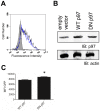MHC class I antigen presentation of DRiP-derived peptides from a model antigen is not dependent on the AAA ATPase p97
- PMID: 23844095
- PMCID: PMC3699533
- DOI: 10.1371/journal.pone.0067796
MHC class I antigen presentation of DRiP-derived peptides from a model antigen is not dependent on the AAA ATPase p97
Abstract
CD8(+) T cells are responsible for killing cells of the body that have become infected or oncogenically transformed. In order to do so, effector CD8(+) T cells must recognize their cognate antigenic peptide bound to a MHC class I molecule that has been directly presented by the target cell. Due to the rapid nature of antigen presentation, it is believed that antigenic peptides are derived from a subset of newly synthesized proteins which are degraded almost immediately following synthesis and termed Defective Ribosomal Products or DRiPs. We have recently reported on a bioassay which can distinguish antigen presentation of DRiP substrates from other forms of rapidly degraded proteins and found that poly-ubiquitin chain disassembly may be necessary for efficient DRiP presentation. The AAA ATPase p97 protein is necessary for efficient cross-presentation of antigens on MHC class I molecules and plays an important role in extracting mis-folded proteins from the endoplasmic reticulum. Here, we find that genetic ablation or chemical inhibition of p97 does not diminish DRiP antigen presentation to any great extent nor does it alter the levels of MHC class I molecules on the cell surface, despite our observations that p97 inhibition increased the levels of poly-ubiquitinated proteins in the cell. These data demonstrate that inhibiting poly-ubiquitin chain disassembly alone is insufficient to abolish DRiP presentation.
Conflict of interest statement
Figures






Similar articles
-
Inhibition of the Deubiquitinase Usp14 Diminishes Direct MHC Class I Antigen Presentation.J Immunol. 2018 Feb 1;200(3):928-936. doi: 10.4049/jimmunol.1700273. Epub 2017 Dec 27. J Immunol. 2018. PMID: 29282303 Free PMC article.
-
Distinct pathways generate peptides from defective ribosomal products for CD8+ T cell immunosurveillance.J Immunol. 2011 Feb 15;186(4):2065-72. doi: 10.4049/jimmunol.1003096. Epub 2011 Jan 12. J Immunol. 2011. PMID: 21228349 Free PMC article.
-
Re-examining class-I presentation and the DRiP hypothesis.Trends Immunol. 2014 Apr;35(4):144-52. doi: 10.1016/j.it.2014.01.002. Epub 2014 Feb 21. Trends Immunol. 2014. PMID: 24566257 Free PMC article. Review.
-
Cellular stress increases DRIP production and MHC Class I antigen presentation.Front Immunol. 2024 Aug 23;15:1445338. doi: 10.3389/fimmu.2024.1445338. eCollection 2024. Front Immunol. 2024. PMID: 39247192 Free PMC article.
-
Monitoring peptide processing for MHC class I molecules in the endoplasmic reticulum.Curr Opin Immunol. 2014 Feb;26:123-7. doi: 10.1016/j.coi.2013.11.006. Epub 2013 Dec 11. Curr Opin Immunol. 2014. PMID: 24556408 Free PMC article. Review.
Cited by
-
MLN4924 Inhibits Defective Ribosomal Product Antigen Presentation Independently of Direct NEDDylation of Protein Antigens.J Immunol. 2022 May 15;208(10):2273-2282. doi: 10.4049/jimmunol.2100584. Epub 2022 Apr 15. J Immunol. 2022. PMID: 35428693 Free PMC article.
-
Direct Conjugation of NEDD8 to the N-Terminus of a Model Protein Can Induce Degradation.Cells. 2021 Apr 9;10(4):854. doi: 10.3390/cells10040854. Cells. 2021. PMID: 33918652 Free PMC article.
-
Inhibition of the Deubiquitinase Usp14 Diminishes Direct MHC Class I Antigen Presentation.J Immunol. 2018 Feb 1;200(3):928-936. doi: 10.4049/jimmunol.1700273. Epub 2017 Dec 27. J Immunol. 2018. PMID: 29282303 Free PMC article.
-
Unraveling the regulatory role of endoplasmic-reticulum-associated degradation in tumor immunity.Crit Rev Biochem Mol Biol. 2020 Aug;55(4):322-353. doi: 10.1080/10409238.2020.1784085. Epub 2020 Jul 7. Crit Rev Biochem Mol Biol. 2020. PMID: 32633575 Free PMC article. Review.
-
Varied Role of Ubiquitylation in Generating MHC Class I Peptide Ligands.J Immunol. 2017 May 15;198(10):3835-3845. doi: 10.4049/jimmunol.1602122. Epub 2017 Mar 31. J Immunol. 2017. PMID: 28363906 Free PMC article.
References
-
- Li M, Davey GM, Sutherland RM, Kurts C, Lew AM, et al. (2001) Cell-associated ovalbumin is cross-presented much more efficiently than soluble ovalbumin in vivo. Journal of Immunology 166: 6099–6103. - PubMed
-
- Larsson M, Fonteneau JF, Somersan S, Sanders C, Bickham K, et al. (2001) Efficiency of cross presentation of vaccinia virus-derived antigens by human dendritic cells. Eur J Immunol 31: 3432–3442. - PubMed
-
- Khan S, de Giuli R, Schmidtke G, Bruns M, Buchmeier M, et al. (2001) Cutting edge: neosynthesis is required for the presentation of a T cell epitope from a long-lived viral protein. J Immunol 167: 4801–4804. - PubMed
Publication types
MeSH terms
Substances
Grants and funding
LinkOut - more resources
Full Text Sources
Other Literature Sources
Research Materials

